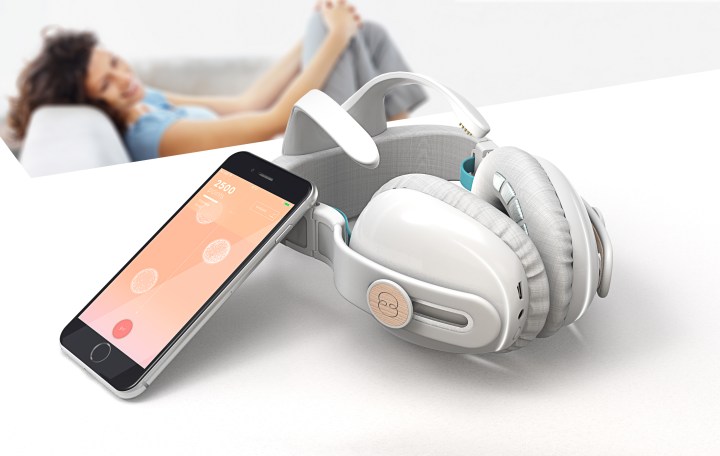
The headset’s called Melomind, and the premise behind it is simple: biofeedback in the form of an electroencephalogram (EEG), a well-established method of monitoring electrical signals within the brain using electrodes. But unlike the curvy, alien-looking prototype Melomind unveiled at CES last year, the new model could almost pass as a pair of oversized headphones. It trades the uncomfortable plastic earpieces of last year’s model for more conventional over-the-ear speakers and relegates the EEG electrodes to two prongs that protrude from the headset’s top.
The headset redesign is primarily the reason Melomind missed its previously planned September ship date, myBrain co-founder Thibaud Dumas told me. Another was the complete reimagining of the companion smartphone app.
The new app was designed with user feedback in mind, said Dumas. The core interface has been improved, and the team’s added a voiceover that explains every step of relaxation sessions. But most dramatic is the addition of a virtual points system that earns you rewards for achieving higher “levels of relaxation.”
“Brain training’s proactive, like a sport or music: the more sessions you do, the better you get,” said myBrain co-founder Dr. Yohan Attal. “It’s important that people use it regularly. So the reward feedback was a way to combine science with a fun experience.”
MyBrain didn’t have a working version of the new headset to demonstrate but ran me through a simulation with off-the-shelf headphones. It begins with what Attal calls an “audio journey,” or ambient noises intermingled to produce a calming mix. Every audio journey begins with a calibration period that measures your baseline brainwave scores and then progresses to a dynamic sequence of music and sound effects determined in real time by Melomind readings. For instance, I heard footsteps in a forest and a choral soundtrack, things that Attal said might not play if my stress levels were lower or higher. “Everyone’s experience is different,” he said. “The changes are computed in real time.”
The Melomind app presents you with a page of results (after every session – “relaxation parameters”, in Melomind’s terms), and assigns a point value based on the level of relaxation that you were able to achieve. Accumulate higher point values and you’ll unlock challenges — longer sessions, for example, or sessions with higher point thresholds. And if there’s a session during which you performed particularly well, you can pull it up — all are recorded for posterity.
The new Melomind’s still very much a work in progress, but Dumas said the company’s shooting for a launch sometime this year, with pre-order and pricing details to come in late January. “It’s an evolution of interaction in terms of neurofeedback and experience for the user,” he said.


